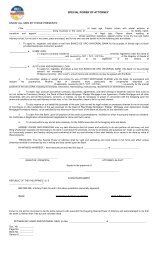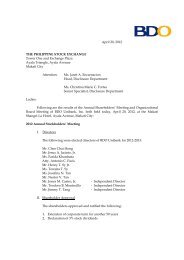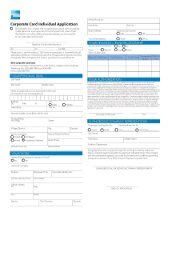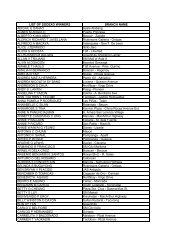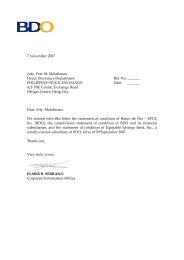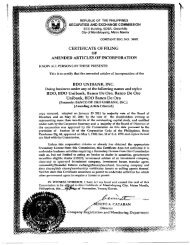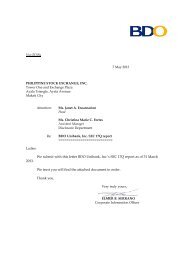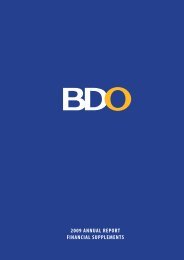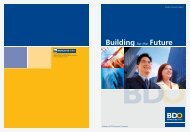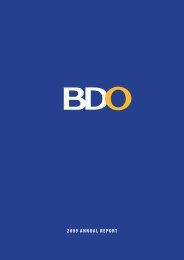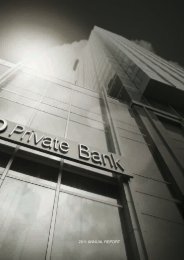Notes to Financial Statements - BDO
Notes to Financial Statements - BDO
Notes to Financial Statements - BDO
You also want an ePaper? Increase the reach of your titles
YUMPU automatically turns print PDFs into web optimized ePapers that Google loves.
<strong>Notes</strong> <strong>to</strong> <strong>Financial</strong> <strong>Statements</strong>DECEMBER 31, 2008, 2007 AND 2006(Amounts in Millions Except Per Share Data)4.3 Operational RiskOperational risk is the risk of loss due <strong>to</strong> the Group’s:• Failure <strong>to</strong> comply with defined operational procedures;• Inability <strong>to</strong> address fraud committed internally or externally;• Inability <strong>to</strong> handle system failures; and,• Inability <strong>to</strong> cope with the impact of external events.The Group manages its operational risks by having policies <strong>to</strong> minimize its expected losses, allocating capital for the unexpected losses, andhaving insurance and/or a business continuity plan <strong>to</strong> prepare for catastrophic losses.FrameworkTrue <strong>to</strong> its commitment <strong>to</strong> sound management and corporate governance, the Group considers operational risk management as a criticalelement in the conduct of its business. Under the Group’s Operational Risk Management (ORM) framework, the Board of Direc<strong>to</strong>rs is ultimatelyresponsible for providing leadership in the management of risk in the Group. The business and service unit heads, as risk owners, areresponsible for identifying, assessing and limiting the impact of risk in their businesses. The RMG provides the common risk language andmanagement <strong>to</strong>ols across the Group as well as moni<strong>to</strong>rs the implementation of the ORM framework and policies.Since 2006, RMG has been conducting workshops with management and their operational risk coordina<strong>to</strong>rs <strong>to</strong> promote risk consciousness,and <strong>to</strong> instill the discipline of risk self-assessment.In 2007, the ORM Policy Manual, which defines the Group’s minimum requirements that must be strictly adhered <strong>to</strong> by all units within the Group,was officially released <strong>to</strong> the merged Bank’s business and service units and subsidiaries. Alignment of their respective policies <strong>to</strong> this Manualhas been on-going.In 2008, RMG continued <strong>to</strong> focus on business continuity, information security, legal and regula<strong>to</strong>ry compliance, outsourcing guidelines andcomplaints management, where substantial mitigating measures have been reinforced.Operational risks are moni<strong>to</strong>red <strong>to</strong> assess, measure and, eventually, manage/mitigate risks using appropriate management <strong>to</strong>ols (e.g.identification of key risk indica<strong>to</strong>rs and key controls; key controls self-assessment; building of the loss database, etc.).5. BUSINESS SEGMENTSFor management purposes, the Group is organized in<strong>to</strong> four major business segments, namely commercial banking, investment banking,private banking and others. These are also the basis of the Group in reporting its primary segment information.(a) Commercial banking – handles the entire lending (corporate and consumer), trade financing and cash management services for corporateand retail cus<strong>to</strong>mers;(b) Investment banking – provides services <strong>to</strong> corporate clients outside the traditional loan and deposit products. These services include loansyndications, underwriting and placing of debt and equity securities, and financial advisory services;(c) Private banking – provides traditional and non-traditional investment and structured products <strong>to</strong> high net worth individuals and institutionalaccounts; and,(d) Others – includes asset management, insurance brokerage, realty management, leasing, financing, remittance, accounting service, creditcard service and computer service, none of which individually constitutes a separate reportable segment.Transactions between the business segments are on normal commercial terms and conditions.Funds are ordinarily allocated between segments, resulting in funding cost transfers disclosed in operating income. Interest charged for thesefunds is based on the Group’s cost of capital. There are no other material items of income or expense between the business segments.Segment assets and liabilities comprise operating assets and liabilities including items such as taxation and borrowings.Internal charges and transfer pricing adjustments have been reflected in the performance of each business. Revenue sharing agreements areused <strong>to</strong> allocate external cus<strong>to</strong>mer revenues <strong>to</strong> a business segment on a reasonable basis.40Thinking Ahead To Get You Ahead • Annual Report 2008



